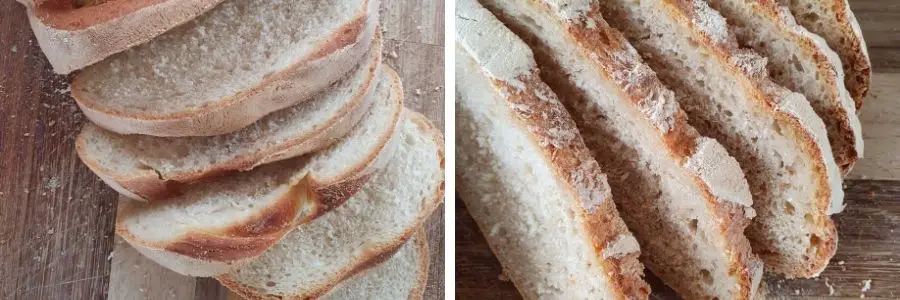Advice on what liquid to use in bread can be confusing, but once you understand the basics surrounding the science behind bread ingredients it makes it much easier to achieve the outcome you want from your homemade bread.
In this post, I’ll explain the different results you can achieve by using water and milk as a liquid in bread dough. So is homemade bread better if it’s made with milk or water?
If you’re looking to make bread with a crispy crust and a chewy texture then it’s better to use water instead of milk. If you want to make a soft bread with a soft crust then milk will help you achieve this. Milk contains fat which helps to create a softer bread which generally stays softer for longer than a bread made with water.
Read on to find out more about the different bread textures you can create by using milk as an ingredient in bread dough.
What does milk do in bread
Adding milk to bread will change the texture of the crumb and the crust. The table below shows the differences you will see when you substitute some or all of the water content with milk v’s bread made with water.
| Bread made with milk | Bread made with water |
| Softer crumb | Chewier crumb |
| Whiter looking bread | more aerated texture |
| Softer, thinner crust | Crispier and thicker crust |
| Stays softer for longer | Tends to go stale quicker |
| Heavier more filling bread | Lighter bread |
| Sweeter flavour | More savoury flavour |
In the image below the bread on the left is an example of a loaf I made which contains milk and the loaf on the right was made using water.
You can see the differences in colour, the texture of the crumb and the thickness of the crust.

How to add milk to bread dough
Adding milk to bread dough can be done in the same way as adding water.
As with water, when you’re adding milk it needs to be just warm or tepid and not cold straight out of the fridge.
If milk is cold it will shock the yeast and make the raising process very slow. I find that using milk in dough can also slow the rise down slightly even when the milk is the right temperature because the dough is slightly heavier.
How much milk should you use in bread dough?
Milk can be used to replace all of the water in the recipe or you could just replace part of it to make the bread softer while keeping the bread a bit lighter than it would be with all milk.
If you’re looking to make a milk loaf, then use all milk to replace the water element of the recipe.
I like to use half milk and half water for bread rolls and burger buns, because that way you get a lighter fluffier roll which is still soft inside and out.
You may find that milk bread has a much heavier feel and it’s more filling than bread made with water.
Milk bread also has a sweeter flavour because of the natural sugars found in milk. In this case, it’s probably not a good idea to add additional sugar to the dough because it will produce bread which is very sweet.
Which milk should you add to bread dough?
The milk you use in your bread is really up to you and the outcome you’re looking fro from your loaf.
Skimmed milk will produce a lighter less creamy looking loaf, where as a full fat or high fat content milk will produce a heavier, yet softer bread which is more filling and will be higher in calories.
I tend to use semi-skimmed milk to achieve a texture which is somewhere in the middle.
Some bakers prefer to use milk powder in their dough instead of milk and this works in the same way as milk by helping to produce a soft loaf.
It’s worth noting that if you go down the milk powder route you will still need to use water as the liquid element of the dough.
TIP: Not sure if you have all the necessary bread baking equipment at home? Check out my recommended picks below (Amazon links):
-
- Scale: Nicewell 22lb Digital Kitchen Scale
- Mixing Bowls: OXO Stainless Mixing Bowls Set
- Pastry Scraper: OXO Stainless Pastry Scraper
- Loaf Pan: OXO Non-stick Loaf Pan
- Kitchen Thermometer: ThermoPro Digital Thermometer
- Stand Mixer (optional): Kenwood Kmix Stand Mixer
Using buttermilk in bread dough?
Buttermilk is a nice ingredient to use in baking and can be used with milk and water in bread dough and in some cases on its own as the liquid element of bread dough.
It is heavier than milk, but it works well mixed with water or milk and it helps to produce a soft and creamy bread texture with a nice flavour.
Buttermilk is often used in soda bread to help create it’s distinctive texture, to find out more, you may like to read ‘how to make soda bread’.
You might also like…
I hope this post has explained the differences between using milk and water in bread dough and how you can use either to produce different textures and bread types.
You might also find the following related articles helpful:
